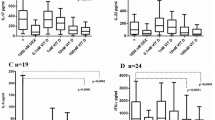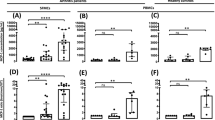Abstract
Piroxicam and other antiarthritic drugs were compared with respect to their effects on T-lymphocyte/monocyte/rheumatoid synovial cell interactions leading to inflammatory mediator production. Piroxicam inhibited PGE2 formation by blood mononuclear cells, but was less potent than indomethacin. Both drugs enhanced suboptimal phytohemagglutinin (PHA)-stimulated tritiated thymidine (3H-TdR) incorporation by mononuclear cells, although optimal responses were less affected. Exogenous interleukin-2 (IL-2) enhanced suboptimal but not optimal PHA responses, and the effects of the cyclo-oxygenase inhibitors were overcome by exogenous PGE2, Thus piroxicam and indomethacin prevented the inhibition by endogenous monocyte-derived PGE2 of IL-2 secretion and activity. Other antiarthritic drugs, including antimalarials, immunosuppressive agents and gold salts, inhibited PHA-induced lymphocyte proliferation regardless of the level of stimulation. Mepacrine and chioroquine were more effective in inhibiting the release of mononuclear cell factor (MCF) that stimulated PGE2 synthesis by synovial cells. Cyclosporin-A, azathioprine and 6-mercaptopurine were more potent as antiproliferative agents than as inhibitors of mediator release. Sodium aurothiomalate and aurothioglucose selectively interfered with lymphocyte-mediated amplification of MCF release, whereas auranofin inhibited spontaneous production of monocytes and the action of MCF on synovial cells. In rheumatoid synovial cells, piroxicam and indomethacin inhibited PGE2 production but not collagenase release. Suppression of MCF release could lead indirectly to reduction of IL-2 and collagenase as well as PGE2 production and consequently to more profound inhibition of immunologically-mediated inflammation.
Similar content being viewed by others
References
Lewis, G. P. 1983. Immunoregulatory activity of arachidonate metabolites and their role in inflammation.In Prostacyclin thromboxane and leukotrienes.Br. Med. Bull. 39:243–248.
Gordon, D., M. A. Bray, andJ. Morley. 1976. Control of lymphokine secretion by prostagiandins.Nature 262:401–402.
Bray, M. A., D. Gordon, andJ. Morley. 1978. Prostaglandins as regulators in cellular immunity.Prostaglandins and Medicine 1:182–199.
Smith, J. W., A. L. Steiner, andC. W. Parker. 1971. Human lymphocytic metabolism. Effects of cyclic and noncyclic nucleotides on stimulation by phytohaemagglutinin.J. Clin. Invest.50:442–448.
Goodwin, J. S., A. D. Bankhurst, andR. P. Messner. 1977. Suppression of human T-cell mitogenesis by prostaglandins.J. Exp. Med. 146:1719–1734.
Gordon, D., D. C. Henderson, andJ. Westwick. 1979. Effects of prostaglandins E2 and I2 on human lymphocyte transformation in the absence and presence of inhibitors of prostaglandin biosynthesis.Br. J. Pharmacol. 67:17–22.
Dayer, J.-M, S. M. Krane, R. G. G. Russell, andD. R. Robinson. 1976. Production of collagenase and prostaglandins by isolated adherent rheumatoid synovial cells.Proc. Natn. Acad. Sci. USA. 73:945–949.
Dayer, J.-M., J. Breard, L. Chess, andS. M. Krane. 1979. Participation of monocytemacrophages and lymphocytes in the production of a factor that stimulates collagenase and prostaglandin release by rheumatoid synovial cells.Clin. Invest. 64:1386–1392.
Mizel, S. B., J.-M. Dayer, S. M. Krane, andS. E., Mergenhagen. 1981. Stimulation of rheumatoid synovial cell collagenase and prostaglandin production by partially purified lymphocyte-activating factor (interleukm-1).Proc. Natn. Acad. Sci. USA. 78:2474–2477.
Smith, K. A. 1980. T-cell growth factor.Immunol. Rev. 51:337–357.
Amento, E. P., J. T. Kurnick, A. Epstein, andS. M. Krane. 1982. Modulation of synovial cell products by a factor from a human cell line: T-lymphocyte induction of a mononuclear cell factor.Proc. Natn. Acad. Sci. USA. 79:5307–5311.
Pantalone, R. M., andR. C. Page. 1975. Lymphokine-induced production and release of lysosomal enzymes by macrophages.Proc. Natn. Acad. USA. 72:2091–2094.
Wahl, L. M., S. M. Wahl, S. E. Mergenhagen, andG. E. Martin. 1975. Collagenase production by lymphokine-activated macrophages.Science 187:261–263.
Littman, B. H., andS. Ruddy. 1977. Production of the second component of complement by human monocytes: stimulation by antigen-activated lymphocytes or lymphokines.J. Exp. Med. 145:1344–1352.
Gordon, D., andA. M. E. Nouri. 1981. Comparison of the inhibition by glucocorticosteroids and cyclosporin-A of mitogen-stimulated human lymphocyte proliferation.Clin. Exp. Immunol. 44:287–294.
Jose, P. J., D. A. Page, B. E. Wolstenholme, T. J. Williams, andD. C. Dumonde. 1981. Bradykinin-stimulated prostaglandin E2 production by endothelial cells and its modulation by anti-inflammatory compounds.Inflammation 5:363–378.
Carty, T. J., J. D. Eskra, J. G. Lombardino, andW. W. Hoffman. 1980. Piroxicam, a potent inhibitor of prostaglandin production in cell culture. Structure-activity study.Prostaglandins 19:51–59.
Emori, H. W., G. D. Champion, R. Bluestone, andH. E. Paulus. 1973. Simultaneous pharmacokinetics of indomethacin in serum and synovial fluid.Ann. Rheum. Dis. 32:433–435.
Wiseman, E. H., andJ. A. Boyle. 1980. Piroxicam (Feldene).Clinics in Rheumatic Diseases 6:585–613.
Baker, P. E., J. H. V. Fahey, andA. Munck. 1981. Prostaglandin inhibition of T-cell proliferation is mediated at two levels.Cell. Immunol. 61:52–61.
Rappapokt, R. S., andG. R. Dodge. 1982. Prostaglandin E inhibits the production of human interleukin-2.J. Exp. Med. 155:943–948.
Bray, M. A., andD. Gordon. 1978. Prostaglandin production by macrophages and the effects of anti-inflammatory drugs.Br. J. Pharmacol. 63:635–647.
GiLLis, S., G. R. Crabtree, andK. A. Smith, 1979. Glucocorticoid-induced inhibition of T-cell growth factor production. 1. The effect of mitogen-induced lymphocyte proliferation.J. Immunol. 123:1624–1631.
Gordon, D., A. M. E. Nouri. andR. U. Thomas. 1982. Effects of antiarthritic drugs on the release of mononuclear cell factors (MCF) that stimulate prostaglandin (PG) E2 production by rheumatoid synovial cells.Int. J. Immunopharmac. 4:311.
Lipsky, P., andM. Ziff. 1977. Inhibition of antigen- and mitogen-induced lymphocyte proliferation by gold compounds.J. Clin. Invest. 58:455–466.
Walz, D. T., M. H. Di Martino, andA. Misher. 1971. The suppression of adjuvant-induced arthritis by gold sodium thiomalate in the rat.Ann. Rheum. Dis. 30:303–316.
Gerber, R. C., M. R. Whitehouse, andK. J. Orr. 1972. Effect of gold preparations on the development and passive transfer of experimental allergic encephalomyelitis in rats.Proc. Soc. Exp. Bio. Med. 40:1379–1384.
Borel, J. F., D. Wiesinger, andH. U. Gubler. 1978. Effects of the antilymphocytic agent cyclosporin-A in chronic inflammation.Eur. J. Rheum. Inflammation 1:237–241.
Bolton, C., andM. L. Cuzner. 1980. Modification of EAE by nonsteroid anti-inflammatory drugs.In The suppression of experimental allergic encephalomyelitis and multiple sclerosis. A. N. Davison and M. L. Cuzner, editors. Academic Press, London, 189–197.
Bunjes, D., C. Hardt, W. Solbach, K. Deusch, M. Rollinohof, andH. Wagner. 1981, Studies on the mechanism of action of cyclosporin-A in the murine and human T-cell response in vitro.In Cyclosporin-A. D. G. White, editor. Elsevier Biomedical, Amsterdam, 261–280.
Walz, D. T., M. J. Di Martino, L. W. Chakrin, B. M. Sutton, andA. Misher. 1976. Antiarthritic properties and unique pharmacological profile of a potential chrysotherapeutic agent, SK&F D-39162.J. Pharmac. Exp. Ther. 197:142–152.
Author information
Authors and Affiliations
Rights and permissions
About this article
Cite this article
Gordon, D., Lewis, G.P. Effects of piroxicam on mononuclear cells. Inflammation 8 (Suppl 1), S87–S102 (1984). https://doi.org/10.1007/BF00915716
Issue Date:
DOI: https://doi.org/10.1007/BF00915716




